Dossier Laméca
VODOU MUSIC IN HAITI
3. THE GUINEA ROOM
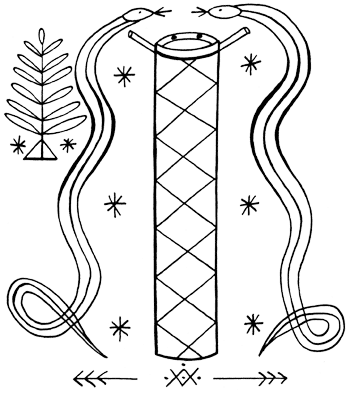
Vèvè for Danbala & Ayida.
The African roots of the Haitian people reach into various parts of the continent, but the ancestors came largely from two regions. This room introduces you to the living legacy of one: the Guinea Coast. The peoples from this region who most visibly impressed Afro-Haitian spirituality lived in the lower parts of modern Benin and Togo. They comprised the Fon, Mahi, Ewe, Hueda, Adja, Ouatchi, and others from the Ayizo language group.
The Fon word vodu, signifying divinity, mystery, ancestor, has become the name of the Afro-Haitian belief system. The Fon also contributed ason (rattle), djevo (antechamber, initiation room), ogan (bell), oungan (male priest), ounsi (initiate), and vèvè (sacred diagram).
The spirits these peoples brought to Haiti constitute the nation called Rada (probably a corruption of Allada, a city in southern Benin), but over the course of Haitian Vodou’s evolution, Rada has opened its arms to other peoples of the region: the Anago-Yoruba of modern Nigeria (Nago nation); the Igbo, also of modern Nigeria (Ibo nation); the Ghédévi clan of ancient Abomey (Gede nation); and the cult of Azaka Mede, a spirit from Benin assimilated into an indigenous family of earth deities (Djouba nation).
Think of the Vodou pantheon as a spectrum of spiritual energies. Now place the Rada nations on the right end of the spectrum, starting with the Rada nation proper. This nation is cool, so it lies closest to the pole. Its colors are white, yellow, pink; its elements water and air.
As we move away from the pole, we find Agaou, a thunder deity, and then the Djoubas, congenial spirits of the earth and farmers.
The Nagos, a nation of warriors and blacksmiths who work with iron and fire, occupy the next position on the spectrum. Nago spirits are said to have “hot heads.” They drink strong rum and flaunt the symbols of war, but they practice powerful paternal love.
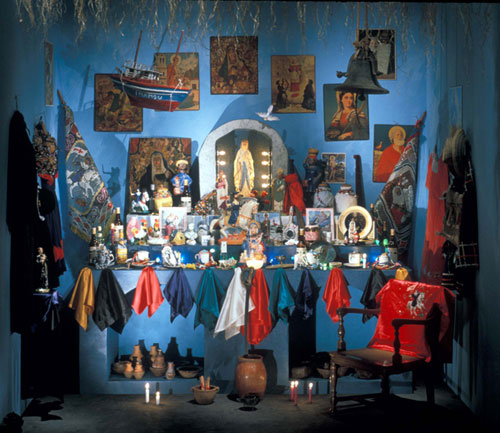
The Rada altar.
UCLA Fowler Museum of Cultural History.
Photo by Dennis Nervig.
Now place the Ibo nation, remembered for the extreme custom of suicide as resistance. In Vodou today we find them mainly in funeral rites, where they escort the dead to Ginen, the spiritual home.
The Gede nation, resident in the underworld and cemeteries, concerns itself entirely with death, but also regeneration as completion of the death cycle. The comic and erotic Gedes wear black and purple. Reserve space at the left end of the spectrum for the Kongo/Petwo room. Each nation performs its own dance or dances and expresses its character in the details of movement. The basic dance of the Rada nation, yanvalou, uses a circular movement that entails contraction of the solar plexis, undulation through the spine, then release of the chest. This serpentine movement evokes Danbala Wedo, a lwa close the heavens because he represents the rainbow with his female aspect Ayida Wedo.
The Rada spirits live in air and water, elements that undulate like the dance yanvalou. The dances parigòl, dawome, fla vodou, mayi, and zepòl also express the Rada spirits and relate to yanvalou in their elasticity. Djouba, danced for the Djouba nation, features the intricate footwork of the barefoot peasant and sometimes movements of agricultural work. As we might expect of a war dance, nago, performed for the Nago nation, uses muscular thrusts. Movements of the dance ibo recall the chains of slavery and the breaking of chains. The dance of the Gedes, banda, is famous for its risqué hip gyrations, evocative of the nation’s eroticism in the service of procreation.
The music of the drum ensemble, lead singer, and chorus set the bodies of dancers in motion so that they might lose their own consciousness and find that of a lwa. Rada, Nago, and Ibo repertories require the use of Rada drums because their cowskin heads withstand the force of the master’s mallet.
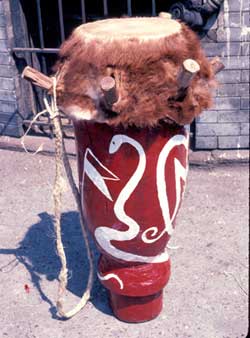
This traditional Rada drum uses a cowhide head attached to a conical hardwood body by means of pegs. Vèvè for Èzili Freda and Danbala Wedo are painted on the body. Note the West African-style tapered base.
The banda dance of the Gedes and the dance djouba use Petwo drums and hand drumming, considered by some drummers to be more relaxed, less formal. Rada, Nago, and Djouba rhythms fall into 6/8 and 12/8 meters that facilitate the simultaneous use of duplets and triplets. Within the 4/4 meter used for the ibo and banda dances, one or more instruments play the asymmetrical kata pattern—two dotted quarter notes followed by a quarter—against the steady quarter notes of other parts. For each Rada and Nago spirit the priest sings a set of two or three songs that go with the slow-tempo dances (yanvalou, parigòl, dawome, fla vodou, nago), then completes the set with a song that drives a fast-tempo dance (mayi, zepòl). Likewise, Djouba sets finish with a song accompanying the fast peasant dance abitan. Rites for the Gede nation begin with a slow banda called yanvalou Gede, then progress to the customary banda.
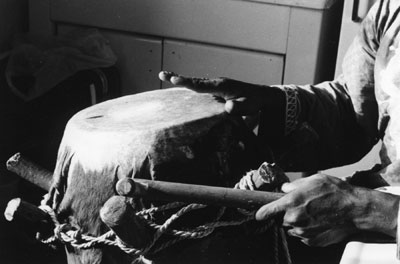
The master drummer plays the Rada drum with hand and stick. Here, he sounds an open mid-range tone with his hand and strikes the side of the drum with his stick.
"Yanvalou/Mayi" (1992) by master drummer Frisner Augustin (extract).
"Nago/Zepòl" (1992) by master drummer Frisner Augustin (extract).
"Djouba" (1992) by master drummer Frisner Augustin (extract).
"Ibo" (1992) by master drummer Frisner Augustin (extract).
"Brav Guede Banda" (1995) by Jacques "Wawa" Fortère (extract).
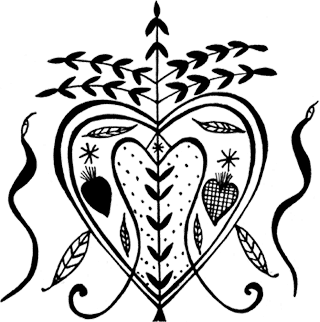
Vèvè for Ezili Freda.
______________________________________
SUMMARY
1. Backdrop
2. The musicians of Vodou
3. The Guinea room
4. The Kongo/Petwo room
5. Work and celebrate: konbit, carnival, and rara
6. Vodou music in neo-traditional contexts: folklore and roots music
Bibliography / Discography
Musical examples
______________________________________
by Dr Lois Wilcken
© Médiathèque Caraïbe / Conseil Général de la Guadeloupe, 2005

